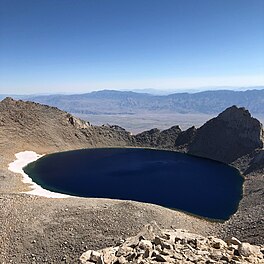| Tulainyo Lake | |
|---|---|
| Lake Tulainyo | |
 Tulainyo Lake viewed from Mount Russell while Tunnabora Peak (left) and The Cleaver (right) frame Owens Valley and the Inyo Mountains | |
Tulainyo Lake's location in the Eastern Sierra | |
| Location | Sierra Nevada, California |
| Coordinates | 36°35′51″N 118°16′48″W / 36.59750°N 118.28000°W |
| Type | Alpine lake |
| Etymology | Portmanteau of the names Tulare and Inyo |
| Primary inflows | Snowmelt |
| Primary outflows | None |
| Basin countries | United States |
| Max. length | 0.5 mi (0.80 km) |
| Max. width | 0.35 mi (0.56 km) |
| Surface area | 84.73 acres (34.29 ha) |
| Max. depth | Unknown |
| Shore length1 | 1.37 mi (2.20 km) |
| Surface elevation | 12,829 ft (3,910 m) |
| Frozen | Regularly in winter |
| Islands | None |
| References | [1] |
| 1 Shore length is not a well-defined measure. | |
Tulainyo Lake is a freshwater alpine lake in the eastern Sierra Nevada in the U.S. state of California, and one of the highest and largest of the alpine lakes of the Sierra. It lies in a large granite bowl bounded by the Sierra Crest to the north, east, and south, at an altitude of 12,829 ft (3,910 m).[2] It lies within Sequoia National Park and the Sequoia-Kings Canyon Wilderness, in close proximity (less than 1.25 miles (2.0 km)) to Mount Whitney, the highest peak in the contiguous United States.
Tulainyo Lake's total volume and depth are not precisely known, but historical news sources report that "the lake lies in a great glacier-gouged bowl of nearly 400 feet depth".[3] The lake's altitude and location at the very crest of the range mean that it is frozen over during the winter, such that it has even been ice skated, and ice and snow often linger around the lake's shoreline well into the summer.[4]
For many years after its initial mapping, Tulainyo Lake was considered the highest lake in the United States, or even North America.[3][5][6] Depending on the definition used, however, multiple "lakes" have been found at higher elevations. Several unnamed tarns in the Sierra Nevada are higher, as are a handful of named bodies of water, including Pacific Tarn in Colorado's Rocky Mountains and Lake Waiau on Mauna Kea in Hawaii.[7][8] The twin volcanic crater lakes of Nevado de Toluca in Mexico sit at approximately 13,800 feet (4,200 m). However, Tulainyo Lake surpasses all of them in size, and may still be the highest named lake in California and the Sierra Nevada.[8]
In large part because of its high elevation, the lake played a notable role in the history of California's Eastern Sierra, and the California water wars, between Owens Valley residents and the city of Los Angeles. In 1937 the lake starred in the so-called Wedding of the Waters celebration honoring the opening of California State Route 190 from Owens Valley to Death Valley.
- ^ "Lake Attribute Data". Archived from the original on April 26, 2022. Retrieved August 26, 2022.
- ^ "Tulainyo Lake Feature Details". USGS Geographic Names Information System. Archived from the original on August 23, 2022. Retrieved August 23, 2022.
- ^ a b "Tulare County Lake Nearly 13,000 Feet In Elevation Is Highest In Entire Nation". Tulare Advance-Register. October 22, 1935. p. 5. Archived from the original on December 28, 2022. Retrieved December 28, 2022.
- ^ Sherman, Leonie (December 3, 2013). "Wild Ice". Adventure Sports Journal. Archived from the original on August 23, 2022. Retrieved August 25, 2022.
- ^ Cite error: The named reference
:4was invoked but never defined (see the help page). - ^ Cite error: The named reference
:5was invoked but never defined (see the help page). - ^ Matthes, François E. "Geological Survey Professional Paper 504—A: Glacial Reconnaissance of Sequoia National Park California". National Park Service. Archived from the original on August 23, 2022. Retrieved August 23, 2022.
- ^ a b "The Highest Lake in the USA". highestlake.com. Archived from the original on May 15, 2021. Retrieved August 23, 2022.

